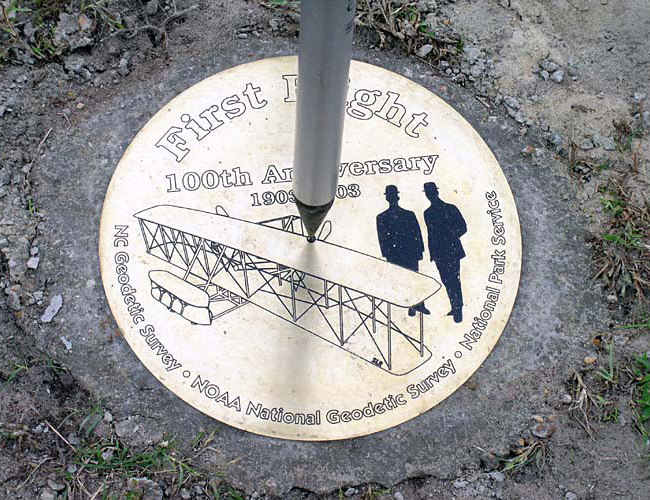 Lewis and Clark Corps of Discovery Bicentennial
Lewis and Clark Corps of Discovery Bicentennial 2002 Winter Olympics – Salt Lake City
2002 Winter Olympics – Salt Lake City U.S. Center of Population: 2000
U.S. Center of Population: 2000 NOAA Heritage Trail: The Calais Observatory
NOAA Heritage Trail: The Calais Observatory Ocean in View! The Nation's Newest Nickel
Ocean in View! The Nation's Newest Nickel 100th Anniversary of the First Flight
100th Anniversary of the First Flight 50th Anniversary of the Fredericksburg Geomagnetic Center
50th Anniversary of the Fredericksburg Geomagnetic Center Fagatele Bay National Marine Sanctuary, American Samoa
Fagatele Bay National Marine Sanctuary, American Samoa Pago Pago Harbor, American Samoa
Pago Pago Harbor, American Samoa Kilauea Point National Wildlife Refuge, Hawaii
Kilauea Point National Wildlife Refuge, Hawaii Hassler Park
Hassler Park 100th Anniversary of the U.S. Forest Service
100th Anniversary of the U.S. Forest Service National Estuarine Research Reserve System
National Estuarine Research Reserve System Hawaiian Islands Humpback Whale National Marine Sanctuary
Hawaiian Islands Humpback Whale National Marine Sanctuary
100th Anniversary of the First Flight
This commemorative disk was set at Kill Devil Hills, North Carolina, on September 17, 2004, to honor the 100th anniversary of the first powered flight by the Wright brothers.

This 12-inch commemorative disk, set at the Wright Brothers National Memorial, in Kill Devil Hills, North Carolina, commemorates the centennial of man-powered flight by Orville and Wilbur Wright on December 17, 1903. This historic event gave birth to the air travel industry, which has made it possible for the average citizen to access all the points of the globe and is a crucial part of the nation's economy and defense today.
This mark was set along with seven other marks on the Outer Banks of North Carolina, including two marks set by the Coast and Geodetic Survey, predecessor to NOAA's National Geodetic Survey (NGS), in 1848 that are among the oldest surviving geodetic survey monuments in the United States.
In addition to being incorporated into the National Spatial Reference System (NSRS), the commemorative disk was designed to inform the public about the role that NGS plays in safe air travel and the development and maintenance of the NSRS. NOAA, the National Park Service, the Federal Aviation Administration, the North Carolina Geodetic Survey, North Carolina Department of Transportation, and the North Carolina Society of Surveyors participated in the dedication ceremony.
Historic Reference
Orville and Wilbur Wright were American brothers credited with making the first controlled, powered, heavier-than-air human flight on December 17, 1903. The first flight, made by Orville covered 120 feet (39 meters) in 12 seconds. In the fourth flight of the day, the one most fully controlled, Wilbur flew 852 feet (279 meters) in 59 seconds. Their altitude on the four flights was about 10 feet above the ground. In the two years after these historic flights, the brothers developed their flying machine into the world's first practical fixed-wing aircraft.

The Wright Flyer (popularly known as the Kitty Hawk) was the first powered aircraft designed and built by the Wright brothers. It is considered by most to be the first successful powered, piloted aircraft.
Since the early 1900s, NOAA has played a role in our nation's aviation industry. Today, NGS administers the Aeronautical Survey Program that provides highly accurate position, height, and orientation information needed for safe air navigation. NGS has been performing aeronautical surveys since the 1920s. These surveys provide critical information about airport features and about obstructions and aids to navigation. The Federal Aviation Administration (FAA) uses this information to establish airport approach and departure procedures, determine maximum takeoff weights, update aeronautical publications, and conducting airport planning and construction studies.
NOAA is also working with the FAA to provide digital data to members of the aviation industry on the location and orientation of runways, taxiways, stands, and more at 60 airports. This pilot program, called "Safe Flight 21," will help develop standardized airport mapping databases and promote safe, efficient surface movements.
- Designation: Not yet in database
- PID: Not yet in database
- Year: 2004
- Location: Kill Devil Hills, North Carolina
- Latitude/Longitude: Not yet in database
- Event Commemorated: To honor the 100th Anniversary of the first powered flight by the Wright brothers
Related Web Sites:
Are We Cleared To Land? The Wright Brothers Help NOAA Show The Way
NGS's Aeronautical Survey Program
